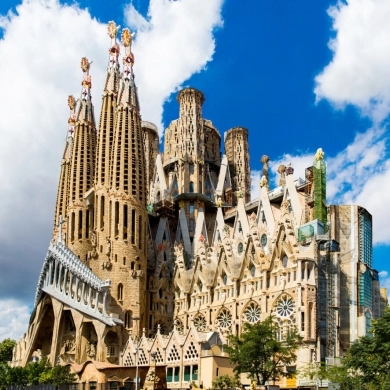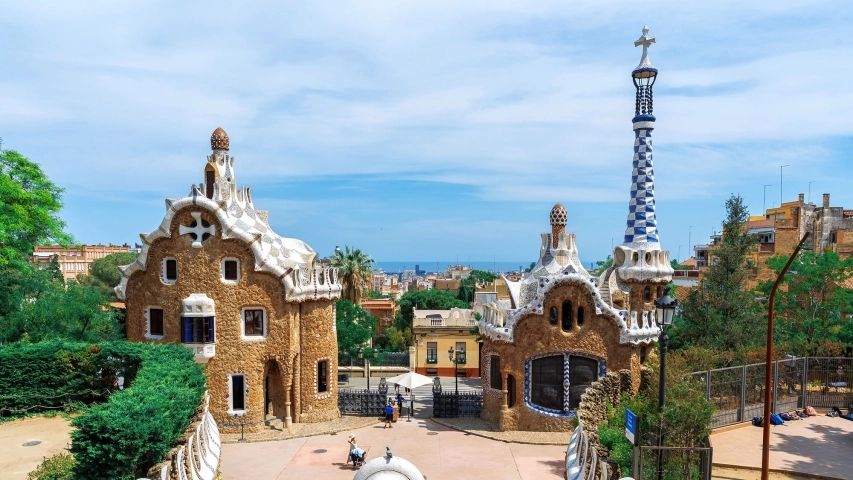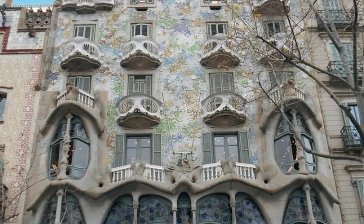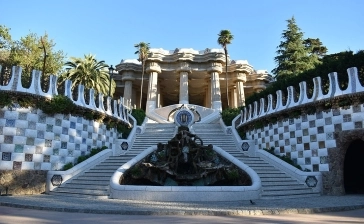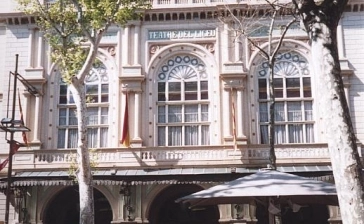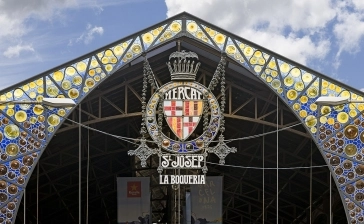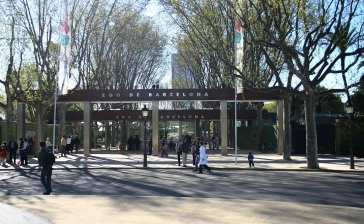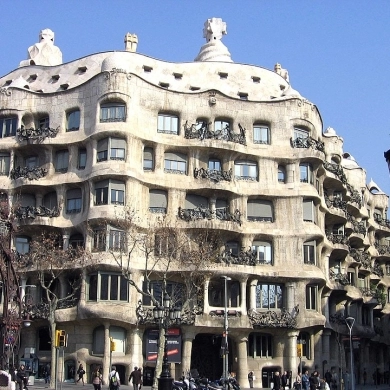Welcome to Barcelona, a magical and accessible city that opens its doors to visitors from all over the world, including those with limited mobility. With its rich history, vibrant culture, and stunning landscapes, Barcelona is the perfect place to explore and enjoy a unique and unforgettable experience.
Barcelona has worked hard to become an inclusive and accessible city for everyone. Here, we present some of the highlights that visitors in wheelchairs can enjoy.
Barcelona's architecture is one of its greatest attractions, and Antoni Gaudí's iconic Park Güell is a prime example. Although some areas of the park may present challenges for people in wheelchairs, there are accessible routes that allow you to enjoy panoramic views and colorful artwork. Additionally, don't miss the opportunity to visit the Sagrada Familia, an architectural masterpiece under construction that features ramps and elevators to facilitate access to its stunning interiors.
The Gothic Quarter, known as the historic heart of Barcelona, is a marvel to explore. Despite its narrow cobblestone streets, many of the main attractions have been adapted to facilitate wheelchair access. Barcelona Cathedral is one example, with ramps and spaces specially designed for visitors with limited mobility.
Barcelona's promenade is another must-see spot to enjoy a leisurely afternoon by the sea. Its wide walkway is completely accessible and offers spectacular views of the beaches and harbor. Additionally, some beaches have wooden walkways and amphibious chairs to allow people in wheelchairs to enjoy the sea with ease.
Regarding transportation, Barcelona has an extensive network of metro, buses, and trams, many of which are adapted for people in wheelchairs. Additionally, the city offers accessible taxi services and adapted vehicle rental options.
We cannot forget Barcelona's rich culinary scene. The city is full of restaurants and bars offering the best of local and international cuisine. Many of these establishments have access ramps, spacious areas, and adapted restrooms to ensure a comfortable and enjoyable dining experience.
Barcelona is a city that celebrates diversity and inclusion, making it a perfect destination for all travelers, including those in wheelchairs. Get ready to immerse yourself in the magic of this Catalan metropolis and discover all it has to offer. We look forward to welcoming you to Barcelona!
To help you make the most of your visit, www.motion4rent.com has compiled a list of important information, including accessible restaurants and other offers for travelers with reduced mobility. We hope you have a fantastic stay in Barcelona!
In Barcelona there are many tourist information points, but we will detail the most important:
Plaça Catalunya Office
The Plaza Catalunya Information Point is a 700 square meter facility located in the heart of the city, providing tourist and cultural information in multiple languages. The staff at Barcelona Tourism have been trained to assist visitors with special needs.
The office is underground, with a stairlift platform available for use by people in wheelchairs at one of the two entrances. To access the office, you will need to go down a set of stairs similar to a metro entrance. Inside, there are two low-height information desks to accommodate visitors in wheelchairs.
If you need any listings or information to be printed in enlarged font, you can request this service from the staff. The store at the Plaza Catalunya Information Point also sells gift items featuring iconic symbols of Barcelona.
Address and contact:
- Plaça Catalunya 17-S 08002 Barcelona
- Telephone: (+34) 932853834
Cathedral Office
Located in the heart of the Gothic Quarter, next to the Barcelona Cathedral, is another tourist information point run by Barcelona Tourism. The staff at this location have also received training on how to assist visitors with special needs.
The entrance from Carrer dels Arcs is almost at street level, with a 2 cm projection. However, the entrance from Capellans street has a 12 cm high step. The counter at this information point is 115 cm high.
Address and contact:
Airport offices, terminal 1 and 2
There are tourist information offices managed by both the Generalitat and the Barcelona Provincial Council at the Barcelona - El Prat airport. The staff at these locations have received training on how to assist visitors with special needs.
While the height of the counter may not be suitable for people in wheelchairs, the staff are always courteous and willing to serve these visitors from the other side of the counter.
Address and contact:
Josep Tarradellas Airport Barcelona:
Barcelona Airport, also known as Barcelona-El Prat, is located 16 kilometers south of the city. As required by Regulation (EC) 1107/2006 of the European Parliament, the airport offers a free care and assistance service for passengers with reduced mobility.
This service is available to all passengers with disabilities or reduced mobility and can be requested at least 48 hours in advance to ensure a smooth journey from the moment you arrive at the airport. To request the service, you can call the telephone number (+34) 91 321 10 00 or submit an online request.
Barcelona's port:
The port of Barcelona is fully accessible to disabled tourists, with elevators available at all major locations to make it easy to navigate the area in a wheelchair.
Additionally, the Blue Bus (cruise shuttle bus service) is also adapted for travelers with reduced mobility.
Train:
Barcelona is well-connected by train, making it easy to travel to France, other parts of Spain, and within Catalonia.
Renfe, the main rail transport company in Spain, offers a personalized assistance service called ATENDO for travelers with disabilities.
- contact:
- Telephone: (+34) 902 240 505.
- email: oca.accesibilidad@renfe.es
To request assistance from ATENDO, you must make the request at least 12 hours before the departure of your train. Be sure to clearly specify your disability and any specific needs you have for your trip.
The main train stations in Barcelona, Estació de Sants and Estació de França, offer a permanent assistance service. If you need assistance at these stations, you can simply present yourself at the customer service center at least 30 minutes before the departure of your train.
Once you arrive at your destination, www.motion4rent.com can provide transportation to your hotel or other desired location. If you need to reserve a vehicle with www.motion4rent.com, be sure to select the "delivery" option for airport pickup, which is typically an optional service.
Metro:
Barcelona is a benchmark city for Europe in this sense, since the entire Barcelona metro network is accessible, except for a few stations (13 of the total 165 stations).
Stations pending adaptation:
- Line 1 (L1): Plaça de Sants, Espanya, Urquinaona and Clot
- Line 3 (L3): Spain
- Line 4 (L4): Maragall, Verdaguer, Urquinaona and Ciutadella-Vila Olímpica
- Line 5 (L5): Virrei Amat, Maragall, Verdaguer and Plaça de Sants
Bus:
Barcelona's public bus system is fully accessible for people with disabilities, with over 1,000 urban and intercity buses that are low-rise and equipped with a boarding and disembarking ramp and reserved space for people with reduced mobility, wheelchair users, and those with strollers. These buses are available both during the day and at night, as well as on neighborhood routes.
Like the metro, the ticket validation machines on buses emit acoustic and visual messages to ensure that people with visual or hearing impairments can confirm that their ticket has been properly validated. The public address system in bus shelters and on buses is also being progressively implemented, along with visual information displays.
Taxi:
People with reduced mobility can request the service of an adapted taxi in Barcelona, which provides the same service as a regular taxi at the same rates. These vehicles are equipped to accommodate passengers with disabilities and operate using a meter.
To request an adapted taxi, you can visit the following website: https://taxi.amb.cat/s/es/usuari/taxi-adaptat.html
It's worth noting that Barcelona taxis may apply supplements for trips to train stations, the airport, cruise terminals, as well as for luggage and special nights.
Barcelona's beaches are also accessible for people with disabilities. Nova Icària beach, Sant Miquel beach, and the Forum bathing area all offer bathroom support services and accessible changing rooms. The Nova Icària beach, in particular, has an inclusive changing room that is fully accessible for people with reduced mobility.
The service at these beaches includes areas with inclusive changing rooms equipped with amphibious chairs, lifting cranes, life jackets, and parasols. There is also a team of 9 qualified aquatic lifeguards available to assist people with reduced mobility who need personal and technical help to access the water. Staff are also present to control access and ensure the proper use of the facility.
All of Barcelona's beaches have accessible parking, routes to the beach, visual and tactile signage and information, adapted toilets, wooden paths to the water, and adapted showers with chairs. There is also adapted public transportation available to facilitate access to the beaches. In particular, the Nova Icaria beach offers the following accessibility features.
The beach of “Nova Icaria”
Nova Icària beach is located east of the Port Olímpic and is characterized by the metallic fish sculpture designed by architect Frank Gehry. This beach was created as part of the urbanization of Vila Olímpica in the 1980s, when Barcelona made a commitment to creating an accessible coastline that was open to the city.
The Nova Icària beach offers the following services: rescue and first aid, Town Guard, beach information point, luggage storage, adapted showers and toilets, changing rooms adapted for people with reduced mobility, children's play area, hammocks, parasols, drinks and ice cream kiosks, sports equipment, restaurants, Wi-Fi, and a bathroom support service for people with reduced mobility.
The accessible beaches with bathing support service also have a changing room, amphibious chairs, a lifting crane, life jackets, parasols, and a volunteer service to help people with reduced mobility get in and out of the water and enjoy bathing. This service is available by reservation at 623 450 890.
Entrance:
Entrance to the beach is completely free, the Red Cross has staff that can help you on the following dates and times:
- June: weekends and holidays
- July, August and the first fortnight of September: every day
- Second fortnight of September: weekends and holidays
Accessibility:
Bus Line: H16, V21, V34, V25, V27 and 59, by Metro such as Line 4 (L4), Ciutadella – Vila Olímpica and Bogatell stations
Once on the beach you will have access to the water through ramps. They also have booths to change, umbrellas, showers with chairs, lifting cranes and other amenities for people with reduced mobility.
Accessible and free tour of Barcelona:
This section presents a 100% accessible route for exploring many of the highlights of Barcelona in a wheelchair. The route starts on the Ramblas, which are fully accessible and offer the opportunity to stop for a bite to eat at the Boqueria market. From there, we will continue to the pedestrianized Gothic Quarter, home to the Cathedral of Barcelona and several shopping streets, such as Portaferrissa Street.
Next, we will visit the Born neighborhood and its narrow alleys, where we can stop for a drink or explore the converted Born market, now home to theaters and exhibition halls. If we have time, we can also visit the Raval neighborhood, about a 20-minute walk or wheelchair ride from El Born. Although the Raval neighborhood is not as accessible as some other areas, it is still worth a visit to see the MACBA museum or relax on the terraces of Avenida del Paralelo.
This tour covers a lot of ground and will surely leave you tired and ready to return to your hotel for some rest. However, there are many other corners of Barcelona to discover if you have the time and energy.
The Ramblas
The Ramblas are a must-see for anyone visiting Barcelona. Along this bustling street, you will find iconic buildings like the Gran Teatre del Liceu (the Barcelona opera house), the Palau de la Virreina, and the famous Boquería market. The Ramblas are a hub of activity, with a diverse mix of street performers, tourists, and locals all coming together to experience the unique atmosphere of this vibrant city. From the Ramblas, you can easily access the Gothic Quarter, the port area, Paseo de Gracia, and more.
As the main tourist hub in the city, the Ramblas are fully accessible for wheelchair users.
Maritime area:
Beyond the end of Las Ramblas, you will find the maritime area, which includes the commercial port and Port Vell. Both of these areas are well-adapted for wheelchair users, with few architectural barriers. You can enjoy a range of bars, restaurants, and a lively atmosphere in both places.
If you continue on, you will reach the Barceloneta neighborhood, a charming seaside neighborhood in Barcelona that is relatively easy to navigate in a wheelchair as long as you stick to the main roads or promenade.
Paseo de Gracia
Passeig de Gracia is an elegant and stately street that connects Plaza Catalunya with the Gracia neighborhood. It is named after the neighborhood it leads to and is home to some of the best examples of modernist architecture in Barcelona. This avenue is like an open-air museum, featuring landmarks such as La Pedrera and Casa Batlló by Gaudí, the Amatller house by Puig i Cadafalch, and the Lleó Morera house by Domènech i Montaner. The street is also adorned with Gaudí's organic pavement and Pere Falqués lampposts with white mosaic benches. In addition to its architectural treasures, Passeig de Gracia is also known for its high-end shops and businesses.
Escamarlá Restaurant https://happy.es/lescamarla/
Located on the Bogatell promenade, it is known for its good rice dishes and seafood, as well as having privileged views.
Restaurant accessible to people with reduced mobility.
- Location and how to get there: Paseo Marítimo del Bogatell nº 40, you can get there by metro with lines L1 and L4, by train with lines R2N, R2s, R3, R4 and R7 and with buses 59, H16, V23 and V27
- Contact:
- Telephone (+34) 932 211 366
- Email: escamarla@happy.es
Tragaluz Restaurant http://grupotragaluz.com/
The Tragaluz group has several restaurants throughout Spain, but one of the best known is Barcelona, where they serve delicious salads and a wide variety of Italian and Catalan dishes.
This restaurant is accessible for people with reduced mobility
- Location and how to get there: Located at Passatge de la Concepción nº 5, it can be reached by metro lines L3 and L5 and buses 24, 67, 7, B23 and H10.
- Contact:
- Telephone (+34) 934 870 621
- Email: tragaluz@grupotragaluz.com
Voramar Restaurant https://restaurante-voramar.eatbu.com/
Restaurant specializing in paellas and seafood.
Restaurant accessible for people with reduced mobility and also its bathrooms.
- Location and how to get there: Located on Paseo Joan de Borbó nº 73, it can be reached by metro line L4, by train with lines R15, R2S, RG1 and S2 or by bus with numbers V15 and V19.
- Contact:
